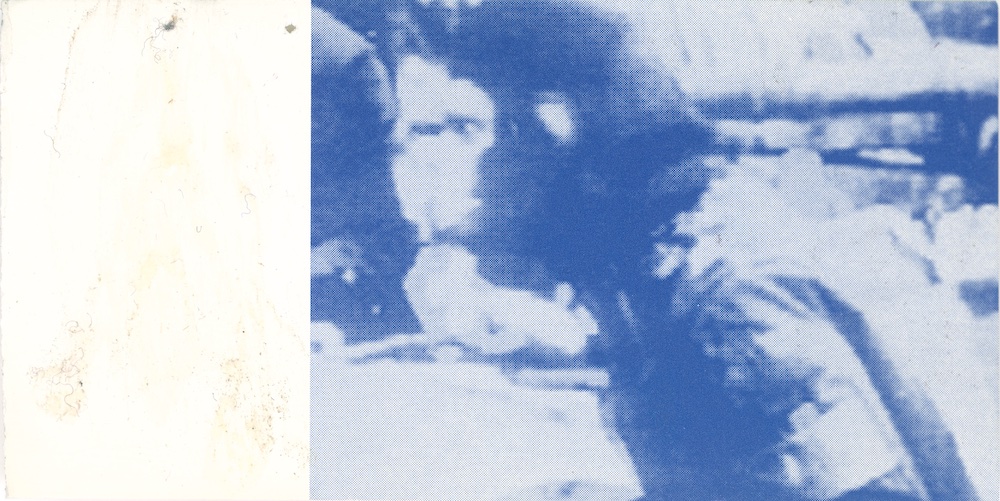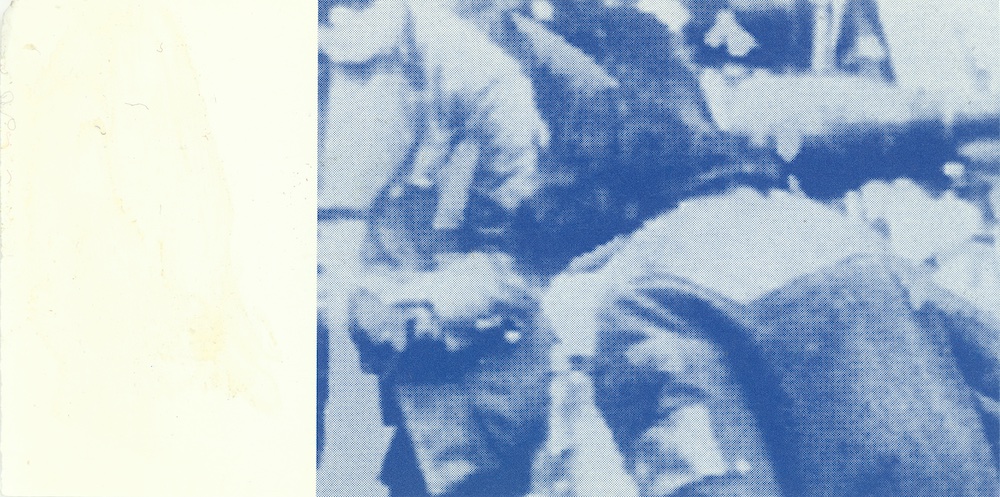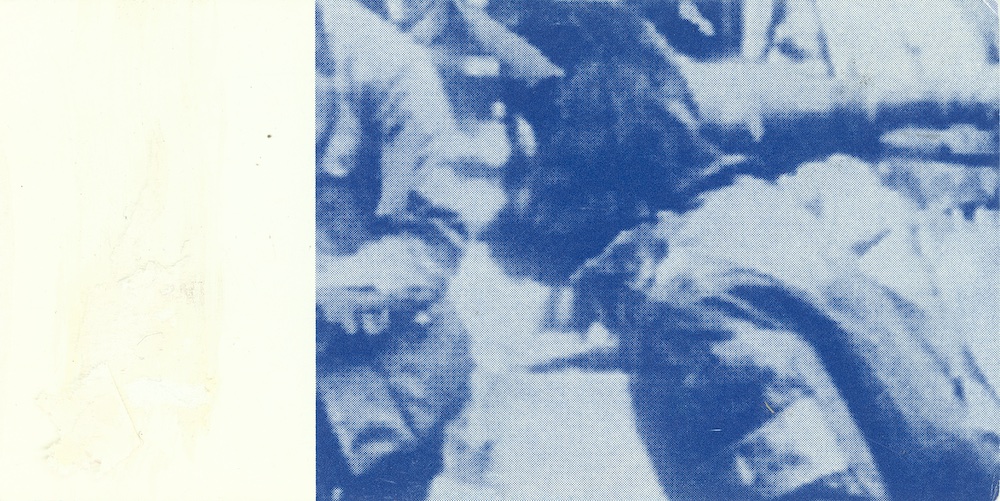HOME // ART / PRINT: APESHIT FLIPBOOK
This limited-edition flipbook features colorized footage generated at the Experimental TV Center in Oswego, NY. A beautiful essay by Lia Gangitano, entitled “Nova,” appears on the verso of every page.




NOVA
By Lia Gangitano
There’s only one reality left. This is here. This is now.
(Taylor (Charlton Heston) Planet of the Apes)
The futurism of the past has caught up. Computers that date no further than 1989 confront the eyes with the dim light of their prompt outdatedness. The early Macintosh computers that comprise Leah Gilliam’s installation Apeshit v3 illuminate Taylor’s prospect: time becomes abbreviated. The images, they’re familiar, nostalgic. But 1973 isn’t that long ago either. Encountering a not so distant past—forced to recede by the velocity of techonology—evokes the subject of time travel, a central lie of science fiction. The Planet of the Apes begins. It’s 3978. All the guys have beards. Going forward in time has made them obsolete.
Originally derived from paintings of scenes, Charlton Heston considered The Planet of the Apes a “new genre: the space opera.” Its status as “racial allegory” has been documented. The grand intentions and aesthetic genealogy that constitute this sci-fi epic seem to thwart the revision of its position as a political statement on race relations. This matter goes unaddressed by the various websites devoted to the films. Perhaps such anachronistic revision must occur on similar terms, that is, formal as well as ideological.
Taylor’s imminent realization that human reign on earth is over is signaled by his discovery of iconic ruins, weighty representations of a destroyed planet. Like the imagined painted vistas of barren topography and the operatic scope of its tragic scenery, the landscape of Apeshit v3 insinuates “a dark, noisy, polyphonic space: a low-tech graveyard, where tools, technologies and ideals might go to die.”1 A monolithic flatness characterizes the cowering early model Macs, rising from scorched grass and reflecting weakly on patina-ed walls. Their beige plastic obsolescence, reminiscent of the talking doll found in the wreckage of the forbidden zone, speaks as lost proof of a limitless future.
- motion of activity. (capture them)
In reference to Gilliam’s 1996 video Sapphire and the Slave Girl, a work that integrates original and archival footage, she comments “I throw these decades up against each other to compare them, because I think very little has changed….”2 In her recent works utilizing an obscure 8mm trailer for Battle for the Planet of the Apes, such as Split, a CD-ROM derived from research into primatology and science fiction, the temporal collision of outmoded and advanced technologies draws attention to the failed progressiveness that the film represents. Apeshit, a videotape by Gilliam, exploits this footage “to highlight the unstable relationship between the real, historical past and the distant, imaginary future. (Briefly released to the amateur film market in the mid 1970s, the ‘reduction print’ is a cheap 8mm duplication sold to encourage the sale of 8mm film projectors and to promote new releases.)”
Like many of Gilliam’s accumulated works, the third installment of the trilogy in question, Apeshit v3, implies prior and subsequent volumes that change names, compose partial histories, remain encyclopedic. Consistent practices, such as the use of video technology to equalize footage from disparate time periods, yield “a feeling of an extended historical present”4 that is central to her address of topics ranging from the naming process to the power of speech. Apeshit v3 exacerbates this historical leveling with the introduction of archaic computers that run movies with varying degrees of aptitude. The images were processed using Paid Raster Control Units, Jones Channel Colorizers and Frame Buffers. Images were compiled and processed digitally, programmed using Macromedia Director and set-up to run on 68030-based Macintosh Computers. An uncanny ability to divulge and mask familiar images, modified and modulating, seems to belie the unsophisticated character of these early Macs.
Gaps between imagined technological futures and present material conditions are customary. William Gibson’s 1984 Neuromancer first introduced the term cyberspace, which the author defined as “a graphic representation of data abstracted from the banks of every computer in the human system,” but the novel was composed on a manual typewriter; and “a large part of the inspiration for ‘cyberspace’ resulted from his first experience wearing a Sony Walkman in the summer of 1981.”5 That a virtual reality was once conceived from a subtle shift in perception caused by walking around the city with a Walkman inspires a return to the streamlined elements and simplified tools that form the evocative content of Apeshit v3.
2. I against I (behold the talking ape)
Battle for the Planet of the Apes, like the four volumes that precede it, involves a battle of speech. In Taylor’s first utterance (“get your stinking paws off me you damn dirty ape”), the conflict is foreshadowed. Battle ends where Planet of the Apes begins. Gilliam comments: “But in spite of its attempts at reversal, Battle remains a partial, colored text. …This dystopian allegory presents a troubling economy of binary oppositions and entrenched racial hierarchies. Futuristic in scope but retrogressive in worldview, the film’s contradictions are technical as well as idealogical. Reduced from 35mm, reprinted in black and white and then subtitled, the cinematic and semiotic codes of the reduction print read as both primitive and prescient.”6 This disparity of languages, formats, is increased exponentially by Gilliam’s treatment and presentation of this piece of contentious evidence. “Is there a relationship between these forgotten formats and the discontinued political ideologies that they depict? Serving up Battle for the Planet of the Apes as proof, Apeshit v3 puts forth tolerance as an outmoded technology.”7
I want to be combed out now.
Reducing what has been referred to here as ideological significance (the political contents of The Planet of the Apes films) to the subtitles that appear intermittently on the computer screens, Gilliam excavates certain phrases to level out the fictional terrain. “Clever ape,” “Are you ready to die, ape?” “Now fight like apes.” function as distillations of an oppositional proposition without a predetermined effect. By recontextualizing their meaning, an inevitable outcome is vaguely rewritten amidst the pathos of destruction. The words “pull back,” appear on an “image intentionally distorted and raster scanned to highlight the ape’s flight to safety.”8
“Virtual reality, cyberspace, digital imaging, and other abstract methods of configuring space, the latest products of a constantly mutating technological environment, have reconfigured our traditional physical experience of the visual.”9 Yet when viewing motion pictures on computers with outmoded speed capacities, the digital image simulates a hand-cranked film, conflating the disparate histories of the filmic and the electronic image. Despite the fact that supposedly high-tech devices generate the images, the recall early cinematic precursors, much like the flip book. “Various optical devices such as the zootrope, the stereoscope, the magic lantern, the praxinoscope, the thaumatope, and the zoopraxiscope both created the illusion of a moving image and exposed its means of production.”10
4. don’t ever talk to strangers
1 Leah Gilliam, project description, Apeshit v3 1999.
2 Gilliam quoted by Meredith E. Holch, “Resharpen the Edge,” The Independent, July 1996:27.
3 Leah Gilliam
4 Meredith E. Holch, “17 Ways to Resharpen the Edge,” The Independent, July 1996: 27.
5 Bruce Headlam, “Walkman Sounded Bell for Cyberspace” (need citation).
6 Leah Gilliam.
7 Leah Gilliam.
8 Leah Gilliam.
9 Chrissie Iles, “The Mutability of Vision,” New Histories, (Boston: The Institute of Contemporary Art, 1996): 110-111.
10 Chrissie Iles: 112.